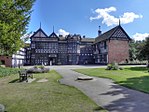Cheadle Hulme railway station
Cheadle HulmeDfT Category D stationsFormer London and North Western Railway stationsNorthern franchise railway stationsPages with no open date in Infobox station ... and 3 more
Railway stations in Great Britain opened in 1845Railway stations in the Metropolitan Borough of StockportUse British English from June 2015

Cheadle Hulme railway station is a station in Cheadle Hulme, Greater Manchester, England. It is operated by Northern Trains. Cheadle Hulme's first railway station opened in 1842, when the Manchester and Birmingham Railway to Crewe was completed. With the extension of the line to Macclesfield, and later Stoke-on-Trent, a new station opened in 1845 which has served the area since.
Excerpt from the Wikipedia article Cheadle Hulme railway station (License: CC BY-SA 3.0, Authors, Images).Cheadle Hulme railway station
Station Approach,
Geographical coordinates (GPS) Address Nearby Places Show on map
Geographical coordinates (GPS)
| Latitude | Longitude |
|---|---|
| N 53.3763 ° | E -2.18778 ° |
Address
Station Approach
SK8 5AS
England, United Kingdom
Open on Google Maps







